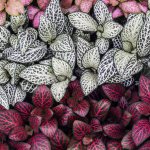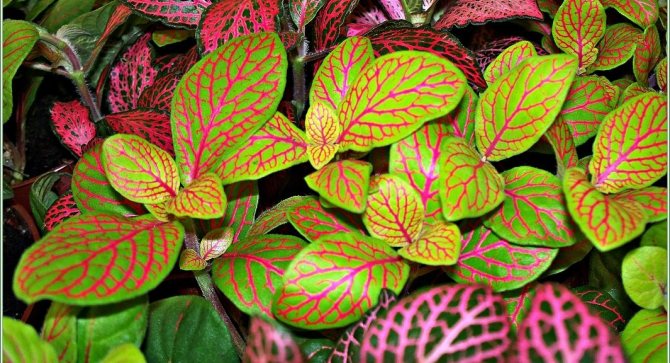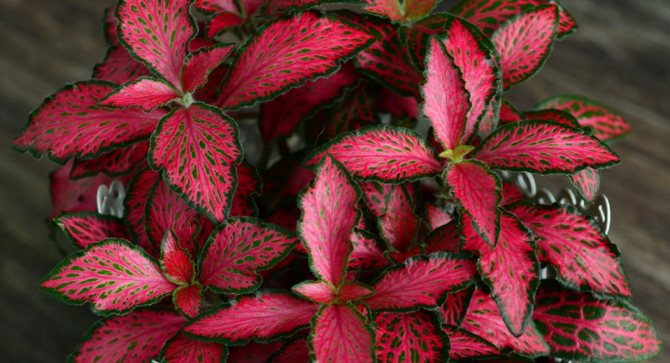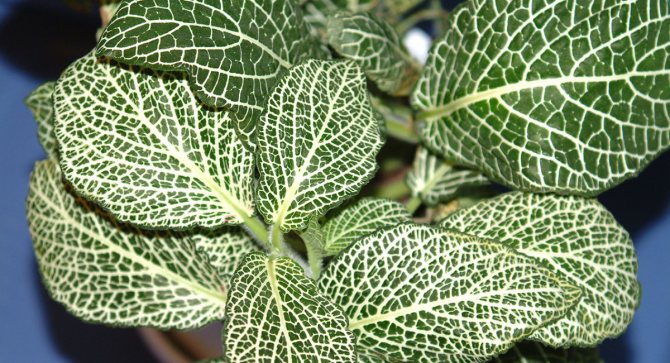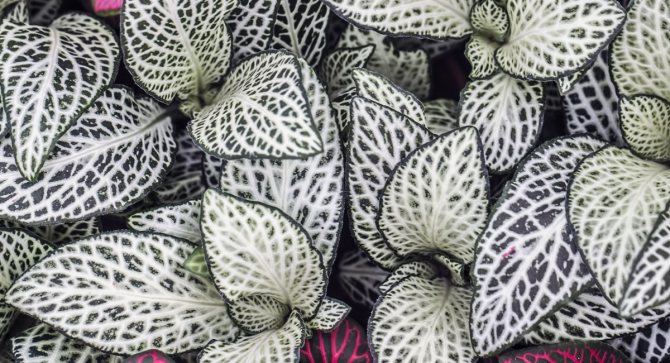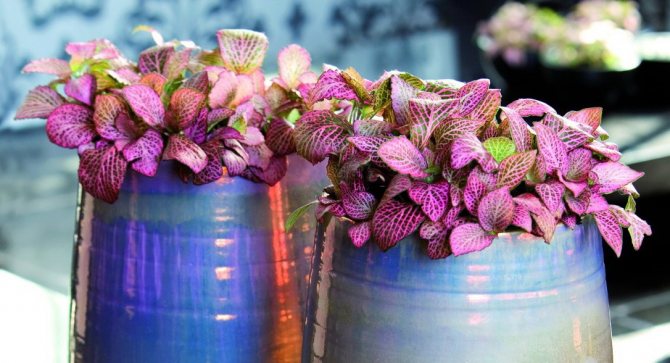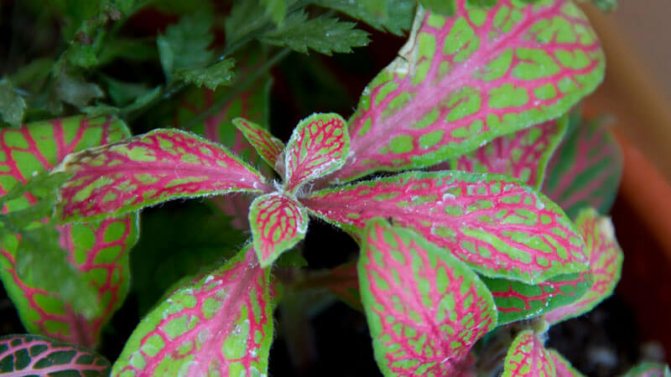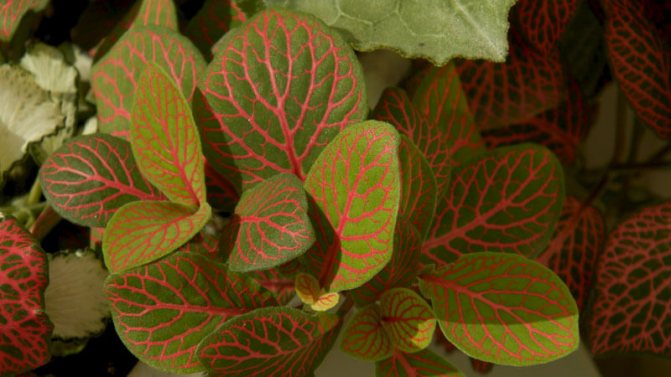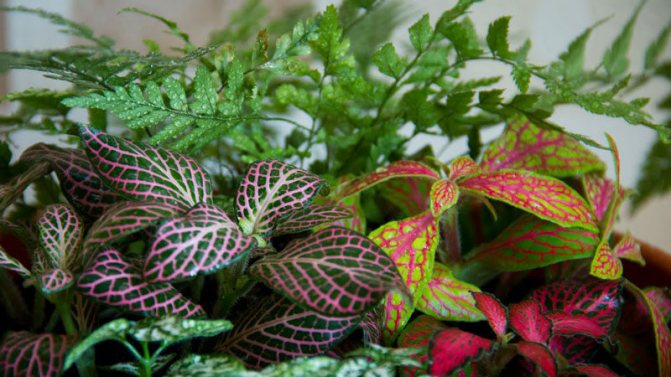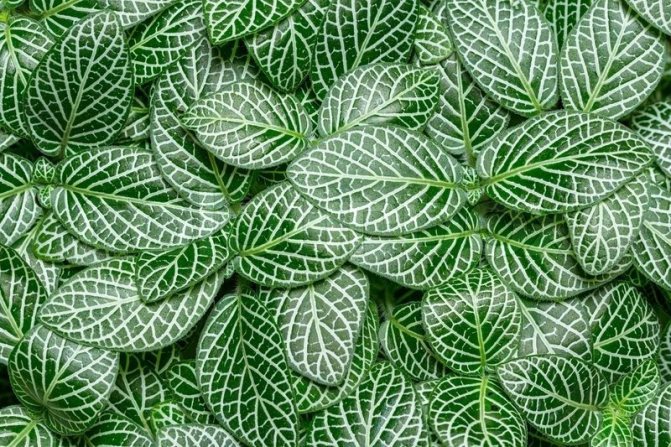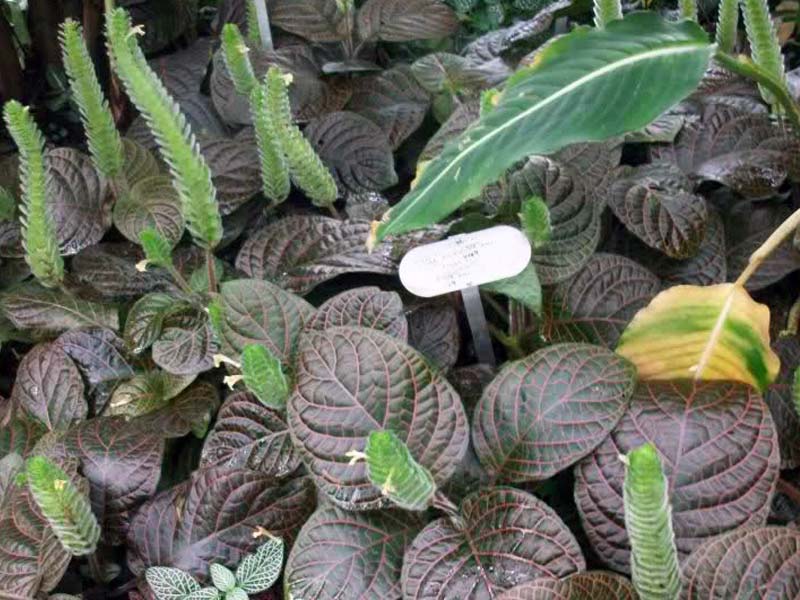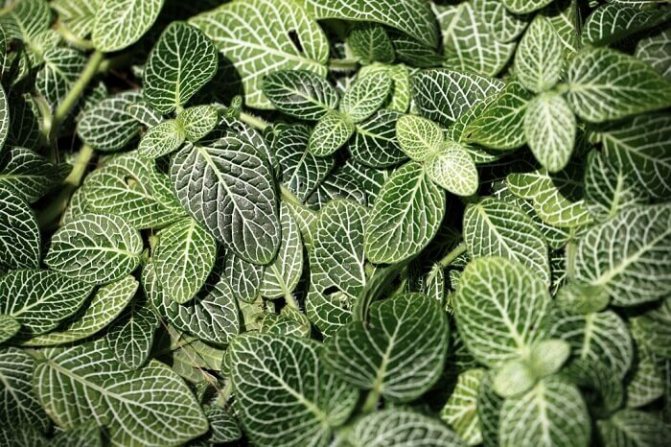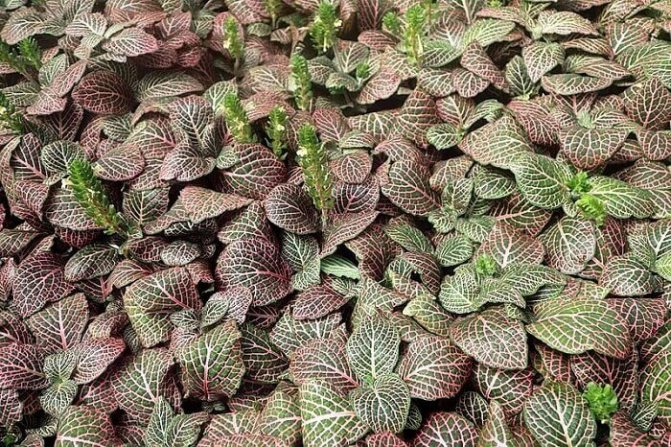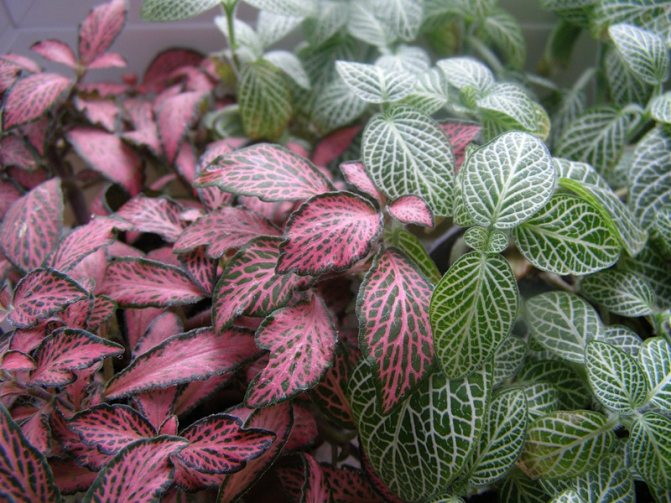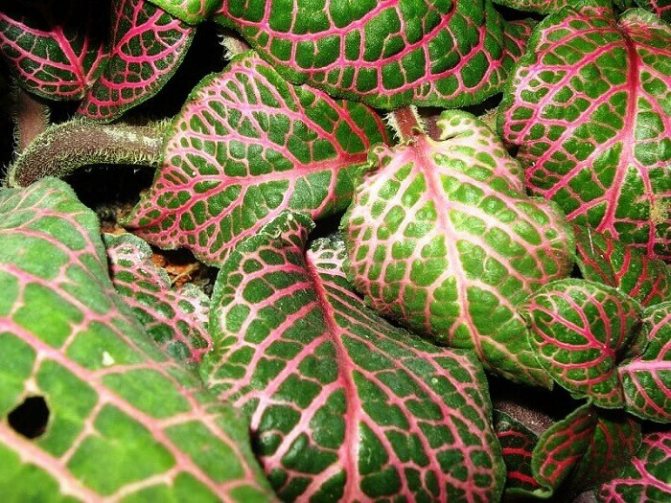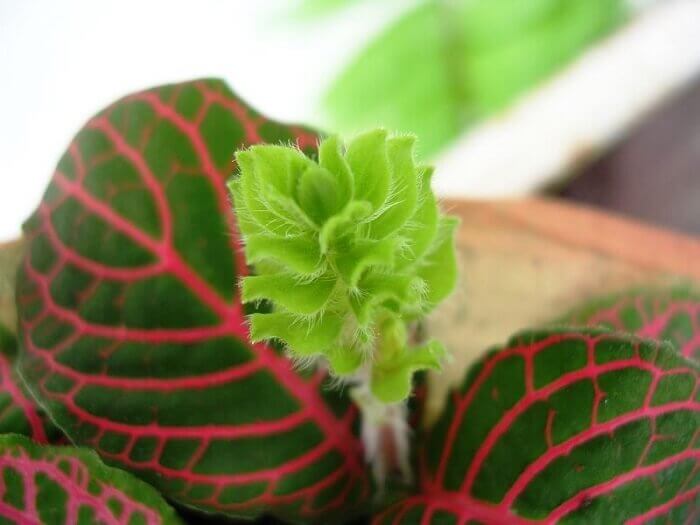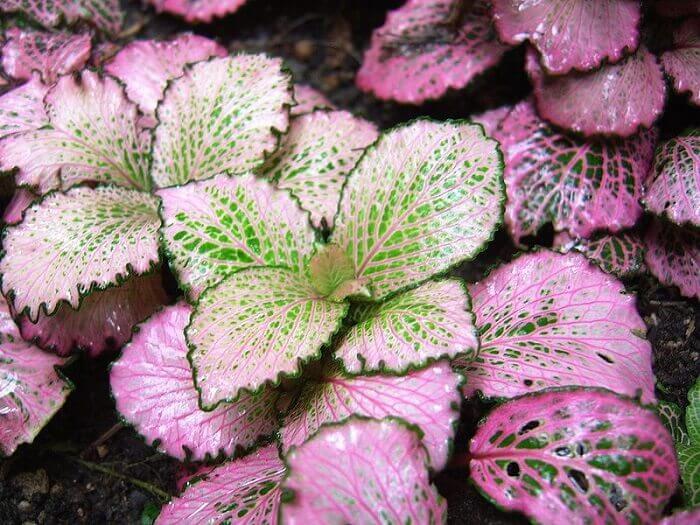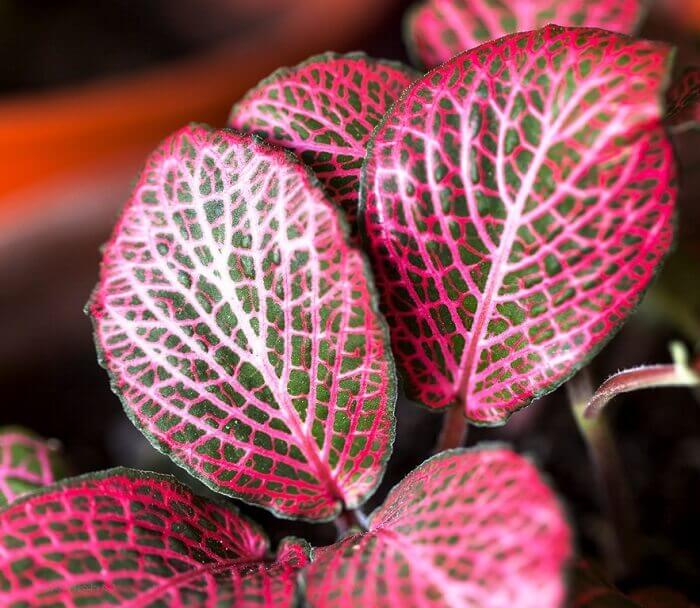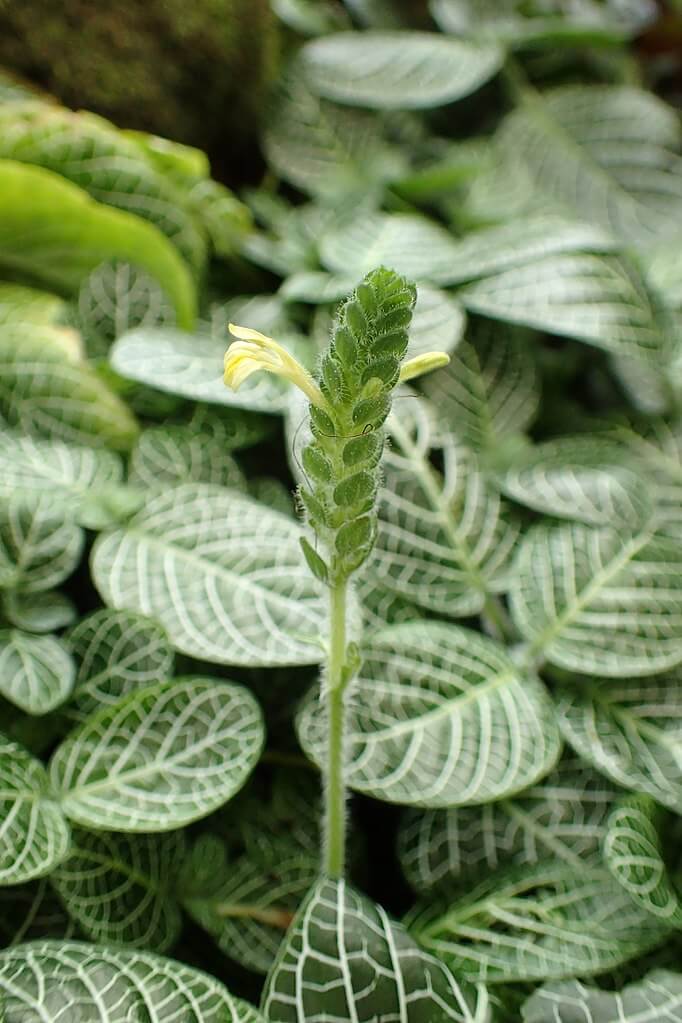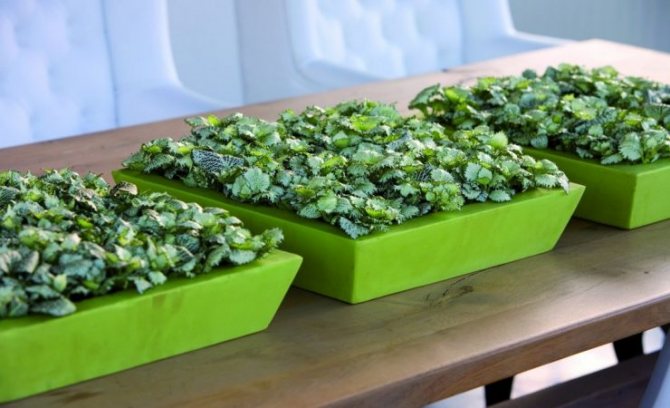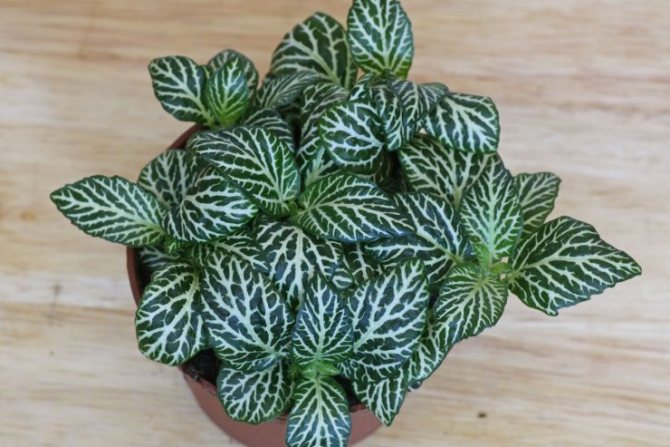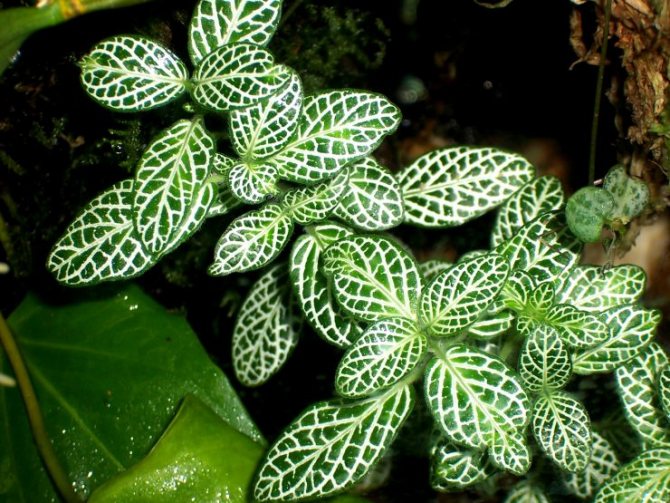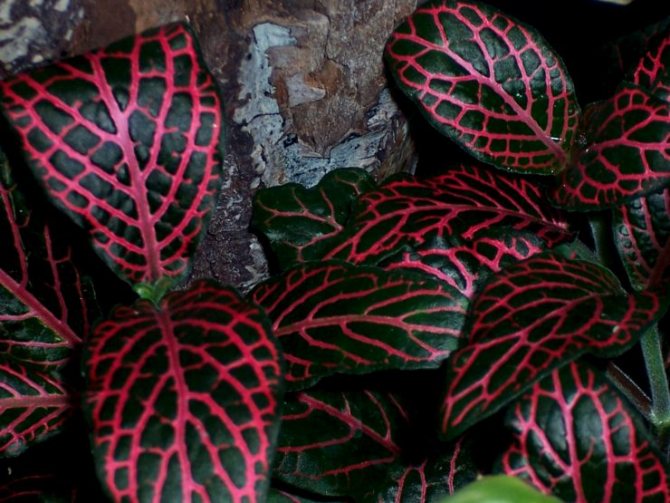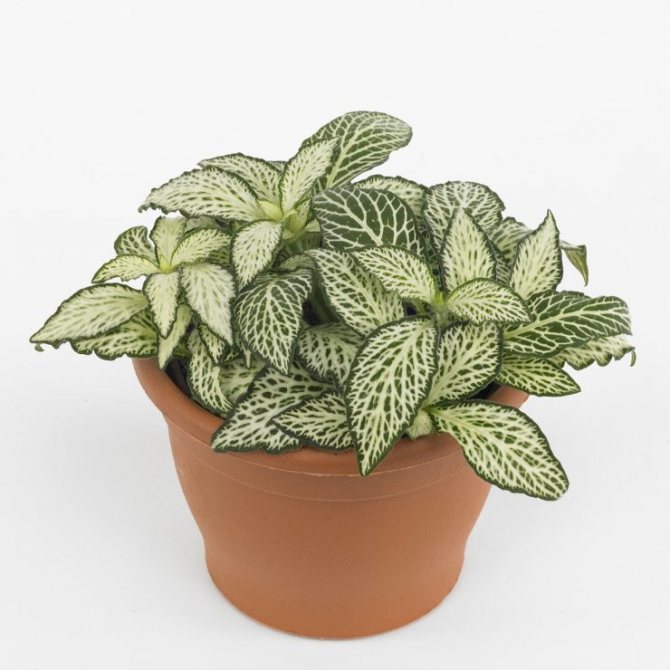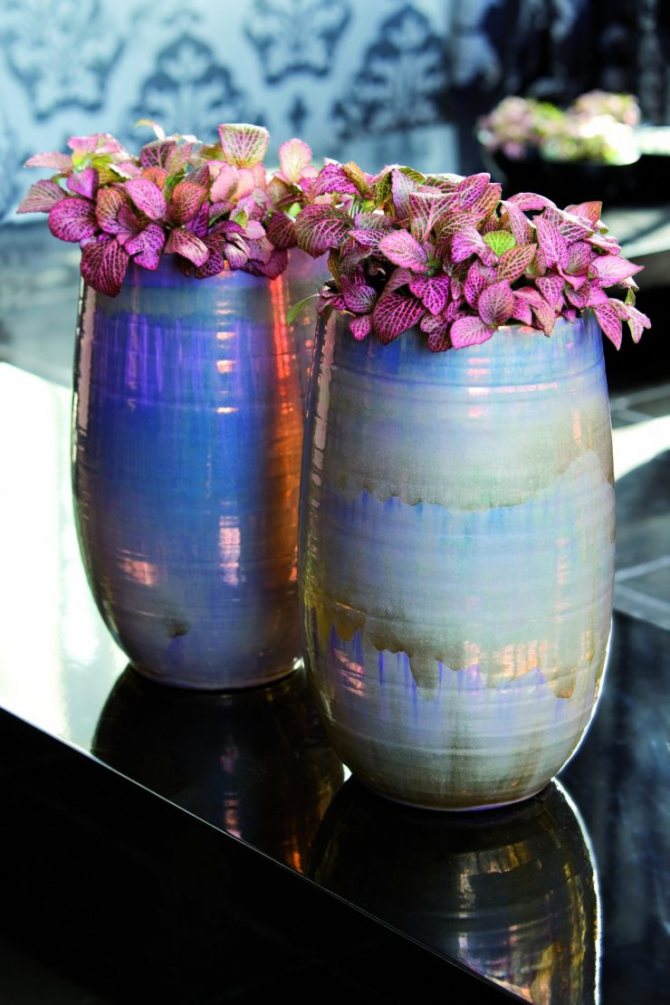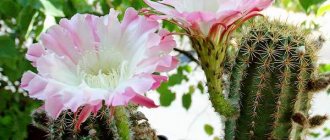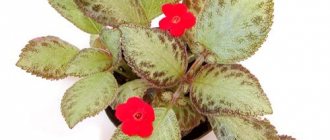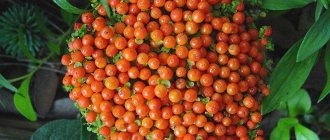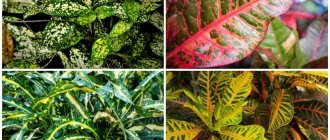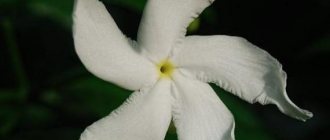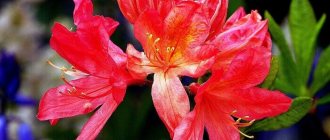Fittonia is a perennial plant, it belongs to the Acanthus family.
In one species, the stems are erect, while in other species, they spread over the soil. In nature, the culture grows near swamps in South America.
The plant was first found in Peru, and then brought to Great Britain in 1867. Most species are stunted plants with creeping stems. The plant got its name in honor of the Fitton sisters - British popularizers of botany.
The photo shows that Fittonia has oval emerald leaves, dotted with a network of veins of different colors. Flowering occurs at home very rarely.
The flowers are very small, yellowish gray or yellowish brown. Florists are advised to immediately cut the buds, since flowering takes a lot of strength from the culture.
If you remember feng shui and signs, then it is believed that Fittonia plant energizes the house with positive energy.
How fittonia blooms
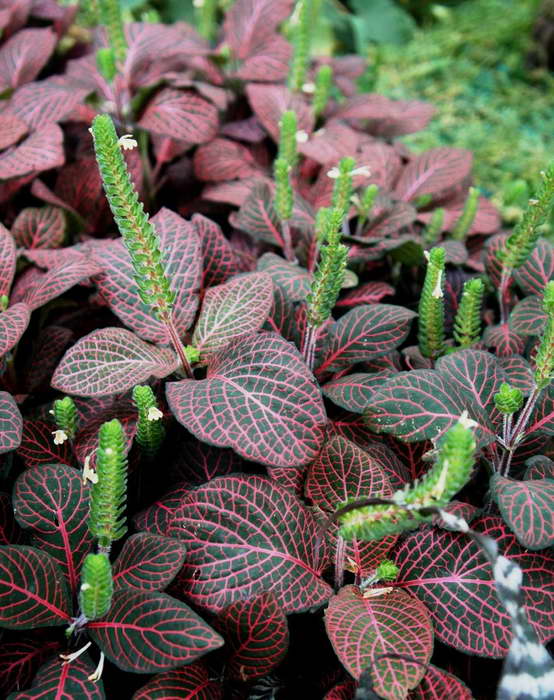
Blooming fittonia photo
The flowering of Fittonia is a spike-shaped inflorescence, consisting of small yellowish flowers.
The plant loves moisture and warmth, so it was originally grown in greenhouses, since it died under room conditions. To date, less capricious varieties have been developed for home cultivation. Experienced growers grow Fittonia in glass bottles, florariums.
Distinctive features of Fittonia


Fittonias are known for their distinctive features:
- they are very demanding on moisture;
- are often finicky and do not like extremes and abrupt changes in care;
- most of the varieties that are present in apartments today are bred by breeders, they are very beautiful and diverse;
- fittonias - mostly low plants, which allows you to create solid carpets from them in winter gardens and greenhouses;
- nondescript flowers.
Nevertheless, many flower growers are very fond of growing this beautiful ornamental plant in apartments.
How to care for Fittonia at home
For successful cultivation of Fittonia, certain rules must be followed. Beautiful appearance and relative unpretentiousness in care contributes to the popularity of the plant in home floriculture.
Air temperature
The plant is thermophilic. The optimum air temperature in spring-autumn will be between 22-25 ° C. In winter, lower it to 20 ° C. Air temperature below 18 ° C will provoke leaf discharge. Fittonia does not like drafts, a sharp drop in temperature, so even in summer, you should not take it to the balcony.
Lighting
Fittonia needs bright diffused lighting without direct sunlight, which will simply destroy the plant. The best place would be east and west windowsills. It tolerates light partial shade well. There is not enough daylight during the winter. In order for the leaves to retain their bright color, it is necessary to resort to the use of special lamps.
Air humidity
Air humidity should be high throughout the year. It is necessary to spray daily, preferably several times a day. It is strictly forbidden to place it near heating systems in winter. You cannot wipe the leaves. To increase the level of humidity, you can periodically place a pot of fittonia on a pallet with wet moss, pebbles, expanded clay.
How to water fittonia
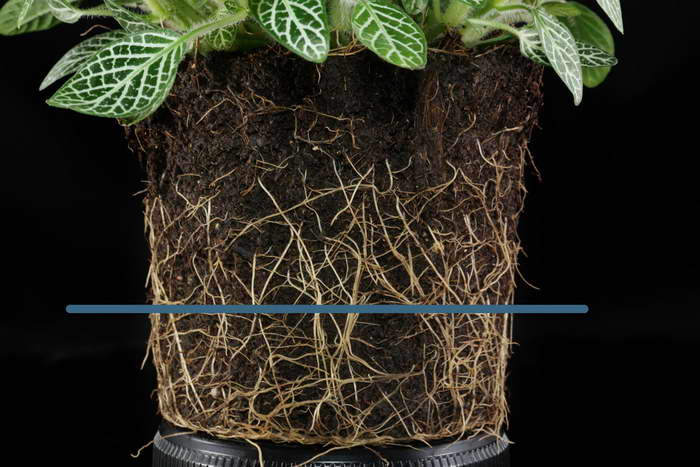

Between waterings, the soil in the Fittonia pot should dry out slightly by 2/3 the height of the pot.
How to water fittonia? In watering, a balance is needed: even a short-term overdrying of an earthen coma leads to the discharge of leaves, and an excess of moisture can provoke decay. The soil needs to be slightly dried between waterings (about two-thirds of the height of the pot), and after watering, be sure to drain the excess water from the pan. Water more often during the warmer months; reduce watering slightly from late autumn.
For watering and spraying, use only soft water at room temperature.
Top dressing
During the active growing season (April-September), it is necessary to apply complex mineral fertilizers regularly, 2-3 times a month. Add half the manufacturer's recommended dose. Fertilizers must be dissolved in water for irrigation and applied to the soil.
Pinching
- To prevent the shoots from stretching and exposing themselves, it is necessary to regularly pinch the tops of the shoots.
- Shorten the shoots half the length each spring.
- Perform pruning in several stages, since radical shortening of the shoots will provoke a slowdown in growth.
Fittonia transplant after purchase and during further vegetation
- Young plants will need an annual transplant in the spring.
- Adult Fittonia are transplanted every 2-3 years.
- The plant has a shallow root system, so choose a wide and shallow container. A plastic bowl is ideal.
- Lay a drainage layer at the bottom. The soil is needed loose, nutritious.
- A soil mixture consisting of 3 parts of leafy earth with the addition of 1 part of humus, peat, sand is suitable.
Fittonia in the florarium
Florariums are bottles, aquariums, large glasses with high legs. The plant is placed in such a florarium, and expanded clay and coconut fiber are poured into the ground.


Plants should not rest against the walls of the container... With this method of planting, it is not necessary to constantly monitor the high humidity of the air, since moisture, when it evaporates, enters the inside of the container. Such a plant is easier to water.


Flowers absorb water, and then it evaporates through the leaves. Condensation occurs on the walls of the tanks. Plants can use it. Water the culture in the florarium with a small amount of water and only after the condensate has dried.
The disadvantage of planting in a florarium is that the plants grow faster than in a pot. Therefore, they are transplanted once every 6 months.
Growing fittonia from seeds
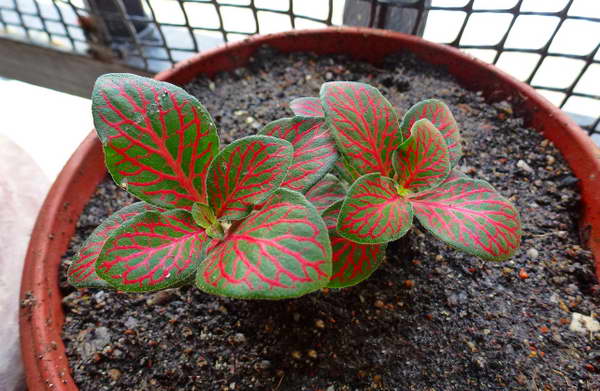

Fittonia from seeds photo of seedlings
Seed and vegetative propagation is used: by dividing the bush, cuttings, layering.
- Sow seeds in spring in a container with peaty-sandy soil.
- Spread the seeds over the surface as rarely as possible, cover the crops with foil or glass, keep the temperature at least 22 ° C.
- Ventilate the greenhouse regularly, spray crops.
- With the emergence of seedlings, gradually accustom to life without shelter.
- When the plants get stronger, you can plant them in separate containers.
In the spring, seeds are planted in a container with soil, which is constantly kept moist at a temperature of at least 22 degrees.
Priming
- Characteristics: nutritious, loose, able to retain moisture.
- Composition: humus, peat, leaf earth and sand in a ratio of 1: 1: 3: 1.
- Drainage: expanded clay, pebbles, broken bricks.
You can prepare the substrate yourself, but with this method there is a chance that the soil will not work because of the content of any impurities. In the store, choose a specialized Fittonia substrate.
Expert opinion
Mokhov Andrey Petrovich
Graduated from KubSAU specialty: agronomy
Disinfect the soil before planting: freeze or ignite. Additionally, saturate it with a solution of potassium permanganate.
Propagation of fittonia by cuttings and layering
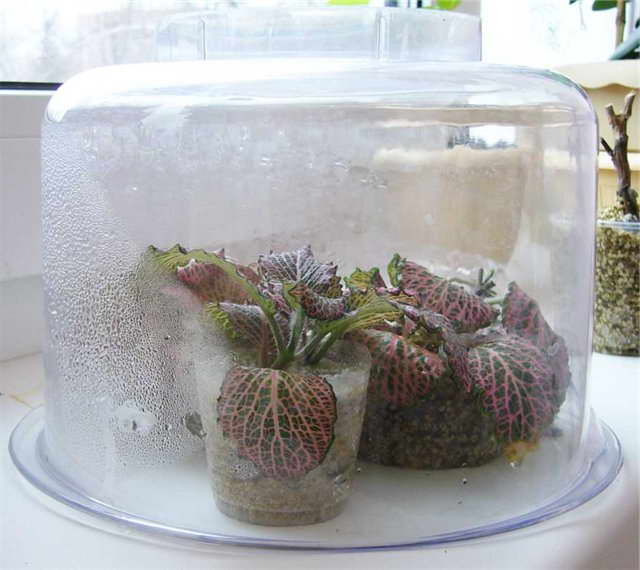

How to root cuttings fittonia photo
- Carry out cuttings in the spring and summer.
- Cut off the apical stalk 6-7 cm long with 3-5 leaves.
- Can be rooted in water (the water level should be 1 cm), in wet sand, peat or peat pellets, sphagnum moss.
- It is necessary to create greenhouse conditions by covering with a bag and maintain the temperature at 22-30 ° C. Ventilate and moisten the soil regularly.
For reproduction by layering, it is necessary to put a pot of soil next to the mother plant, bend the shoot there, cut the leaves from the shoot and sprinkle this place with earth. Separate the rooted cut from the mother plant and grow separately.
Microclimate
| Characteristic | Optimal value |
| Temperature | 20-25˚С, no drafts and temperature drops. |
| Humidity | Increased throughout the year. |
| Lighting | Photophilous, does not tolerate direct sunlight. In winter, you need to supplement it with phytolamps. |
You can maintain the required humidity level by using a pallet with wet expanded clay or moss, as well as regular spraying.
Choosing a place for a flower
Windows on the west or east side will provide the Fitton with the necessary diffused light. But it is better to choose a well-lit place at the back of the room. Please note that the flower should not be left near batteries and open vents.
Mistakes in caring for Fittonia
- The tips of the leaves dry out when the indoor air is dry - do not forget to spray the plant.
- The leaf plates acquire a yellow-brown tint from a lack or vice versa of an excess of nutrients - reconsider the feeding regime.
- Twisted, spotted leaves indicate insufficient watering.
- Sluggish leaves, rotten shoots - the air humidity is too high combined with a low temperature.
- Fittonia leaves lose their color, become thin, dry out. The reason is intense sunlight.
- From dry air or excessive watering, the leaves fall off.
- Intense lighting provokes a loss of color brightness, the leaves become thin and dry.
Seasonal home conditions - table
| Season | Lighting | Humidity | Temperature | Air composition | Optimal location |
| Spring | Intense, diffuse | High:
| 22-25 degrees | Fresh air from a regularly ventilated room | Window sills of windows facing west or east |
| Summer | Light shading | ||||
| Fall | Intense, diffuse | ||||
| Winter | Artificial supplementary lighting 2-4 hours | From 18 degrees | South window |
Important! Fittonia suffers from drafts and sudden changes in temperature, so it is not recommended to leave it on an opening window during the cold season. Summer outdoor exposure is also contraindicated for the plant. It can lose its elegant color not only from a lack of light, but also from excessive direct lighting.
Pests and diseases
The main pests of Fittonia are sucking insects: spider mites, scale insects. Collect the parasites by hand. It is necessary to treat the plant with an insecticide.
Due to the defeat of fungal infections, the following diseases develop: powdery mildew, root rot, mosaic. It is necessary to remove the affected areas, treat with a fungicide. Keep the plant isolated from healthy specimens. If the stage of decay is advanced, carry out an emergency transplant.
Remember that all problems arise from improper care. Follow the recommendations and Fittonia will delight you with its variegated appearance.
Difficulties
Fittonia is quite moody. However, it is better to pay more attention to it, preventing the negative manifestations of improper care, than to reanimate the affected plant later.
Table: curling, drying leaves and other appearance problems
| Signs of improper care | The reasons | Troubleshooting Steps |
| Exposure of the lower part of the stem | Natural aging process | Spring pruning |
| Lethargy and deformation of leaves | Dry air | Spraying and setting the pot on a pallet with wet drainage |
| Too bright lighting | Shading | |
| Leaf lethargy in wet soil | Drying out or decay of roots | Cuttings for growing a new plant |
| Drying the edges of the leaves | Dry air | Daily spraying |
| Insufficient feeding | Adjust the amount and frequency of fertilization | |
| Intensive feeding | Suspend fertilizing and shed water | |
| Lack of light |
|
As you know, any disease is easier to prevent than to cure. To avoid damage to fittonia, you must adhere to all the rules for caring for it. A healthy, strong plant is practically not susceptible to diseases and pests. But if problems do arise, you need to quickly and correctly respond to them.
Table: diseases and pests of fittonia and their control
| Diseases and pests | External manifestation | The reasons | Effects | Remedies | Prophylaxis |
| Root rot | Stopping growth, wilting | Root locking, softening, accompanied by an unpleasant odor | Cessation of nutrition and death of the plant |
|
|
| Aphid |
| Contact with soil or other plants through open windows | Suction of sap from the plant, leading to stunted growth, wilting and death |
|
|
| Mealybug | White cotton-like bloom on leaves |
|
|
| |
| Shield | Brown scales adhering tightly to shoots and leaves | Contact with soil or other plants |
| Systematic inspection of the plant (first of all - the axils of the leaves). | |
| Spider mite | The appearance of white dots and cobwebs on the plant |
|
|
| |
| Thrips |
| Application with soil, other plants or flower cut (asters are especially fond of). | Eating anthers of flowers, leaves, leading to their deformation and wilting. | Three times (after 7 days) treatment (spraying + watering the soil) at a temperature of 20-23 degrees with a solution of Fitoverm insecticides (8 ml per 1 l of water) or Aktar (0.8 g per 1 l of water). |
|
Photo gallery: Fittonia lesions
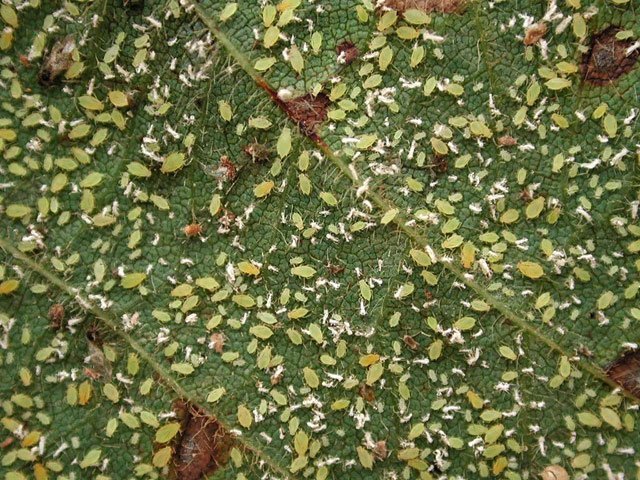

The accumulation of aphids on young shoots is detrimental to the plant


Spider webs and wilting are a sign of spider mite damage
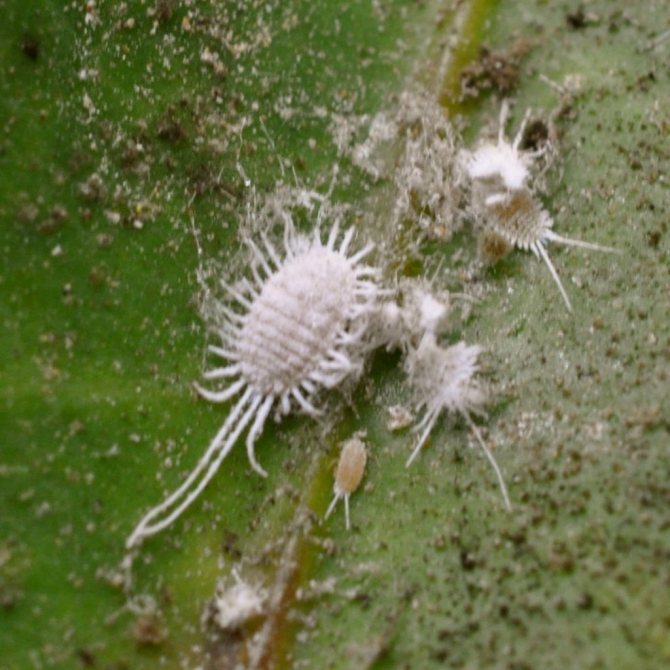

The mealybug lives on the back of the leaves


The result of root rot is wilting and death of the plant
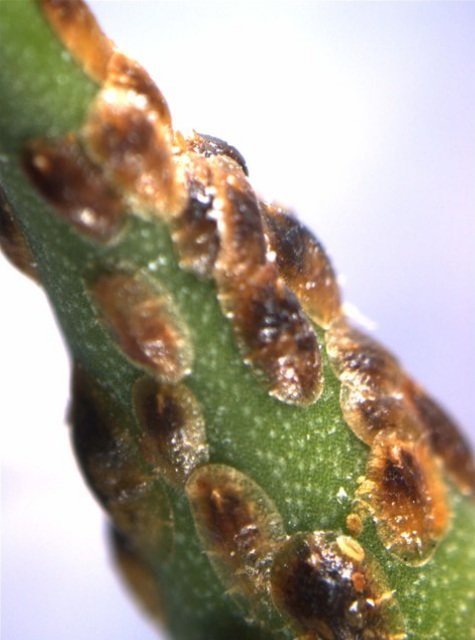

The scabbard looks like a leathery plate, it sucks the juice from the plant
Types and varieties of fittonia with photos and names
Fittonia Verschaffelt or white-tailed fittonia verschaffeltii = Fittonia albivenis
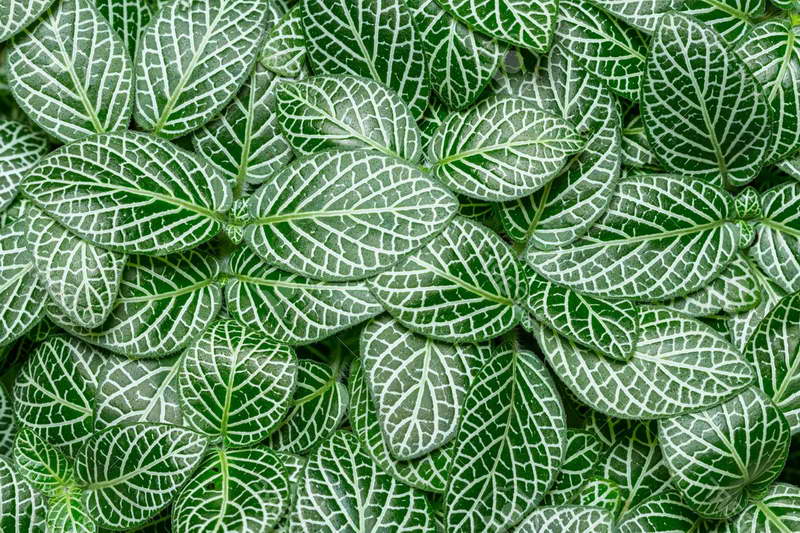

Fittonia Verschaffelt or white-necked fittonia verschaffeltii = Fittonia albivenis photo
A low-growing herb about 25 cm high. The shoots are creeping, the stems branch well. Large leaves have a dark green color with a pattern of veins of white, red, pink.
Varieties:
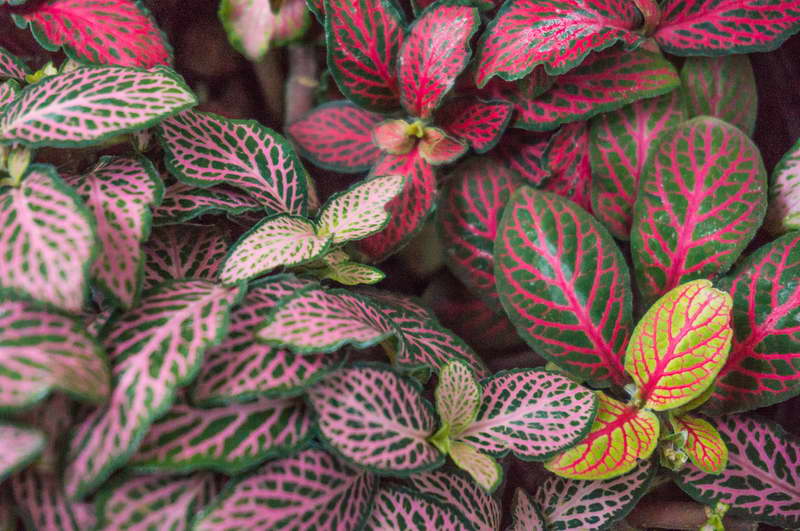

Fittonia Vershaffelt red and pink photo
- Fittonia silvery - leaf plates are smaller, veins of a white-silvery shade.
- Fittonia red - the color of the veins is red, lilac, pink, the center or edges may be more pronounced.


Fittonia Josan Photos
- Josan - the edges of the leaf plate are wavy, the main color is dark green, the veins have a coral hue.


Fittonia white-necked White Anna White Anna photo
- White Anna - dark green leaves are bordered by a darker stripe, the pattern has a white-silver color.
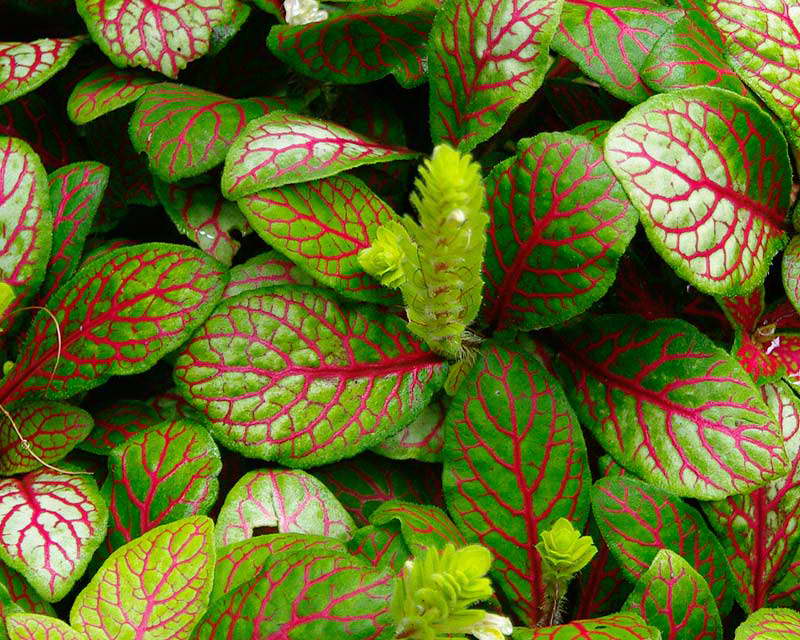

Fittonia albivenis Skeleton photo
- Fittonia Skeleton - the name is derived from the structure and color of the leaf plate. The leaves are small, matte, velvety. A dense network of red-burgundy veins adorns the leaf surface. The main color is olive.
Fittonia giant or large Fittonia gigantea
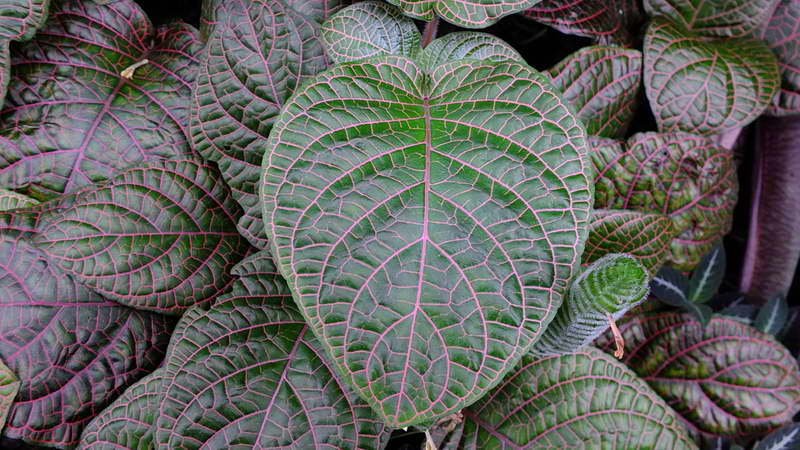

Fittonia giant or large Fittonia gigantea photo
The only species with erect shoots. They are pubescent. The plant reaches a height of about 60 cm. Leaves 10-16 cm long and 4-10 cm wide are attached on short petioles. The leaf plate is glossy, painted in dark green with a pattern of dark pink veins.
Description of the plant
The name Fittonia (from Latin Fittonia) unites four perennial decorative leafy species of the Acanthus family. They came to indoor plant growing from the swampy forests of Peru, where they covered the earth with a bright carpet for many years under dense forests. The main value of each type of Fittonia is the leaves - large, 5-7 centimeters in size, with bright veins, oval in shape. The flowers are not at all decorative, small in size, pale yellow and inconspicuous, they are collected in compact inflorescences that are lost against the background of foliage.
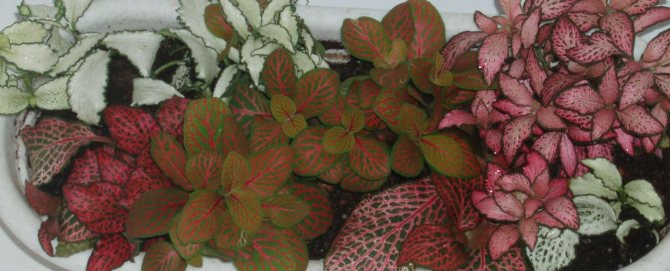

Fittonia Mix photo


Fittonia mix home care photo flowers
Mix plantings of Fittonia of various shades make anyone passing by freeze: after all, this is a real storm of colors, frozen with unthinkable patterns on the leaves of exotic plants. Mix white fittonia with red, silver or pink, add colors of all shades and get an extraordinary miracle from unpretentious plants that delight the eye all year round.
Watering
- In spring and summer: abundant and often as the topsoil dries up.
- Autumn-winter: gradually reduce the frequency, by the beginning of winter, switch to the irrigation regime, when the plant is given water 1-2 days after the top layer of the substrate has dried.
The earth should not be overdried, but it is also not recommended to flood it. Fittonia is prone to a high degree of moisture evaporation through the leaves, so the soil in the pot dries out rather quickly. For irrigation, it is better to use melt, rain or distilled water. If this is not possible, then you will have to water with a water supply that has been processed:
- you need to add a few drops of lemon juice or citric acid powder;
- wait until sediment appears in the form of light gray flakes;
- strain.
If you are going on vacation
- Prepare the plants for your departure: check for diseases and pests, stop feeding in two weeks, thin out the leaves and cut the buds.
- Rearrange the flowers in partial shade, next to each other in trays of damp expanded clay, moss or pebbles.
- Water liberally, spray the leaves, and place hoods over the pots to maintain moisture.
- Purchase or make automatic watering.
Florist reviews
Fittonia is considered a ground cover plant and is most often used to create miniature colored gardens. Multicolored fittonias are planted in a bowl or wide, but shallow tub and supplemented with succulents or other small plants. This baby feels great in very well-humid rooms, requires frequent spraying and watering, but it is not necessary to overmoisten too much so that the roots do not rot, but it should not dry out either, as its beautiful leaves can dry out or fall off. Therefore, you should not keep it on southern windowsills and near heating. Alas, my last Fittonia died from pests. She cannot resist the scabbard and the mite, so it was not possible to save her. Always process new plants that you buy or take somewhere, quarantine them.
LvIcO4ka
I don't have very many indoor flowers yet, but this one takes its place in my modest collection. I bought it as a small sprout in a plastic bowl in the Auchan hypermarket 4-5 months ago. He looked extremely emaciated in completely dry soil and, among the variety of species provided, attracted my attention with his delicate pale green color, and, of course, his exhausted appearance, so there was simply a desire to save him as soon as possible, because a good half of the petals were dried up to such degree that was no longer subject to restoration.
At home, on the very first evening, the plant was lovingly transplanted into a normal soil called "Violet" (soils "Azalea" and "Geranium" are also suitable) in a pot purchased in the same place in "Auchan". All that remained was to wait with hope in my heart for a positive result ... The very next day the flower came to life, and its leaves were filled with juices. I was very pleased with this and this is how he began to look literally a week later.
Alexandra Bond
The plant is unpretentious, loving moisture. It is best not to water such a plant every day, but simply spray or pour water in a saucer under the flower. The plant does not tolerate drafts and sudden temperature fluctuations. The flower grows slowly, but it is a great experience when you admire this plant. I have this family plant. This is the first flower that my husband and I bought after the wedding. He was very small, now he has grown a little, like our family - we have a daughter.
rayani
Fittonia attracted me with beautiful leaves - red with green veins. But the relationship with her did not work out! I grew up in the summer, everything was fine, I sprayed it every day. But with the onset of cold weather, it began to wither. There were five plants in the pot, they grew into a beautiful bush. Now there is only one branch left, the type of plant has become completely different! I read that it can be planted in a pot to any plant, so that Fittonia creates a beautiful view of the composition as a whole (I don't remember what it is called scientifically). In the spring I will buy Fittonia again. The red flowers or leaves of plants are said to increase the vitality of households. I don't have enough energy! Well, I'll wait for spring!
mardan
Features of the


Indoor flowers of Fittonia are small in size, rarely grow more than 60 centimeters, since the shoots always tend to be closer to the ground. These are dicotyledonous plants with slight pubescence.
The most valuable is the egg-shaped leaf plate that is painted in a variety of colors - from green to emerald. On the entire surface of the leaves, veins are observed that have a color different from the main color of the Fittonia.The leaf plates can grow up to 2-16 centimeters in length.
In many ways, flower growers loved this plant for the way it looks. Its shoots are thin and short, therefore they form a semblance of a green carpet. The leaves are arranged in pairs and are located opposite each other along the entire length of the shoots.
But still, the main feature should be considered patterns of stripes and spots, which have a contrasting color and a chaotic arrangement between the veins.
Phytonium blooms extremely rarely, especially at home. And if we talk about hybrid varieties bred, then they have no flowering at all. Moreover, experienced experts advise removing the buds even before they have time to bloom. This is because flowering takes a lot of Fittonia's vitality.
Trying to grow wild varieties at home does not make sense. Such phytonia will not multiply, since they are not adapted to room conditions. They always experience an acute shortage of moisture, and also die due to constant temperature changes.
Fittonia in the aquarium
With a normal amount of light, Fittonia calmly tolerates waterlogging and grows, even if completely immersed in water.
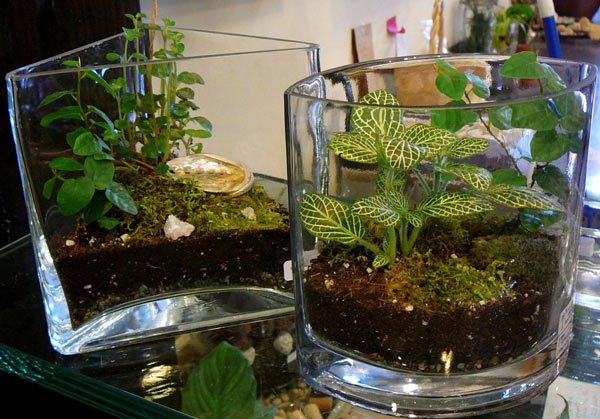

Fittonia can be placed in an aquarium, since the roots of the culture tolerate the increased moisture of the soil well, the top of the plant should be in the air.
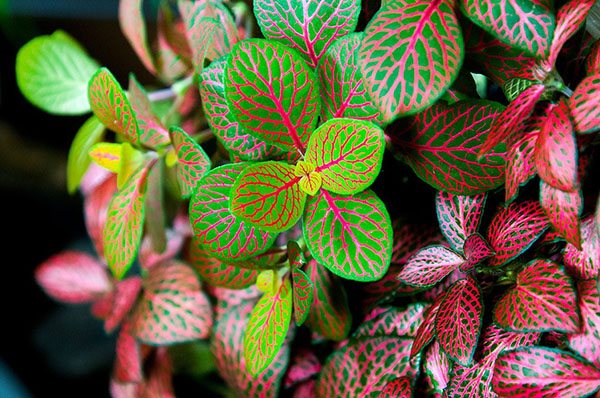

The rainforests of South America are a haven for naturalists and botanists. Even in the century before last, among the lush greenery, scientists were attracted by decorative leafy species of Fittonia. In fact, the plant is not at all large, and if it were not for the original color of oval or ovoid leaves, the creeping shoots of Fittonia would have been waiting for their researcher for a long time.
But how to get past the green-pink, white-green, purple, violet or olive-carmine curtains?
Thanks to the incredible color of the leaves, named after the Fitton sisters, the British popularizers of the botany Fittonia have become incredibly popular with amateur flower growers all over the world.
Fittonia - sleeping pills at home
In the Chinese teachings of feng shui, Fittonia is a symbol of the element of metal, helps to achieve the set goal and get rid of indecision and depression, removes negativity, improves mood.
The plant is beneficial: it cleans the air of microbes, saturates it with moisture, it can be kept in the bedroom for a quiet rest. The flower soothes, helps relaxation, fast falling asleep.
Fittonia is known to attract money. People are convinced of this because of the appearance of the leaves that resemble coins. The plant does not contain poisonous sap and is safe for the home.
General information
At home, only selective species of Fittonia are bred, since the wild are not able to survive in the house. At the beginning of their adaptation, breeders planted the plant in greenhouses, because only there they could create conditions suitable for them: a warm and humid climate.
Later, species were created that are suitable for home keeping and less capricious to the climate. They then live in the apartments of lovers of these plants.
Hybrid Fittonia species are not only less capricious to the conditions of detention, but also brighter than their natural counterparts.
Currently, the largest work on the development of new varieties of Fittonia is carried out in Holland. Breeders bred plants with red, yellow and white leaves.
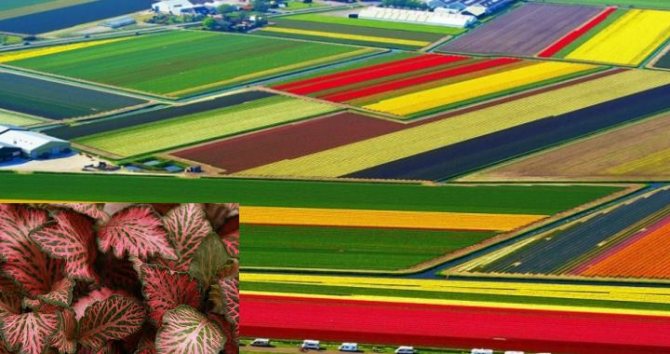

Description
Fittonia is a small herb with a pubescent stem from 10 cm to 60 cm in height and dense foliage, large enough for such a stem - from 6 to 10 cm, have an egg-shaped shape, the tip of the leaf is slightly pointed. Fittonia leaves have different colors, structurally distinguished veins of a color other than the leaf.
Fittonia leaves are not only green in color, but also gray, silver or purple.
Stems of different types of Fittonia differ in length and direction of growth. Short, up to 10 cm in height, grow vertically, they are practically invisible behind the dense foliage that covers it entirely.Long stems creep along the ground, leaves grow densely on them, creating a cover for the lawn.
The colors of the lace of the leaves are different: white, yellow, reddish or pink. It stands out on different colored leaves, creating an exquisite yet austere beauty to the plant.
Fittonia in nature is a flowering plant, but inflorescences, collected in yellowish or white panicles, often go unnoticed, as they hide in bright foliage. At home, the plant rarely blooms, but with proper care it can be achieved.
Interesting! According to legends, Fittonia is the guardian of peace in the family. She absorbs negative energy and defuses the atmosphere in the house.
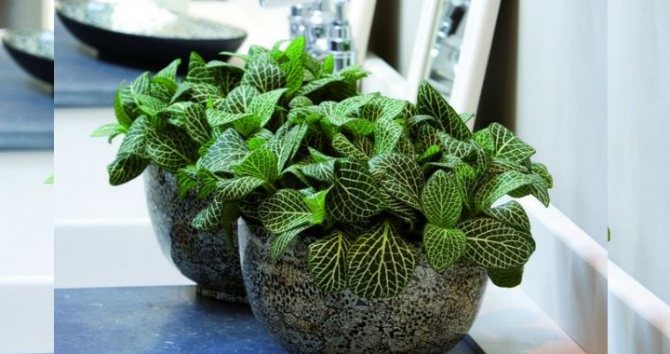

Fittonia types
Important! Fittonia perfectly cleans indoor air. It fights germs and moisturizes the air. Fittonia can be used to decorate a nursery, as it is non-toxic and cleans the air of germs.
- Fittonia Belozhilkovaya is the most favorite and widespread type of Fittonia. Fittonia of Vershaffelt and Serebristozhilkovaya were combined into it. Lives for several years with creeping silvery fluffy stems. Leaves cover them densely. At a more mature age, the color of the stems changes and becomes olive. The plant is not more than 20 cm high. 10 cm olive-colored leaves are covered with a network of white, pink and red veins.
Silvery or Mosaic - This small plant has creeping stems. The leaves are large, covered with a silvery pattern, the shoots take root easily. Drought resistant.
- Nana - this hybrid has small leaves up to 2.5 cm, densely covering the stem of the plant. A white mesh covers the entire leaf blade with a dense pattern. This type of fittonia is resistant to the dry air of residential premises, is not demanding in care and is loved by flower growers for this.
- Perseus - lives well at home. The plant differs from its counterparts in a darker leaf blade with an olive tint and two-color patterns: pink and white. The reverse side of the leaves is bright red.
- White Anna is a small plant with a white leaf pattern and a darker border than the color of the leaf. In addition to White Anna with a similar pattern, there are views with the names White Star and Frankie.
- Skeleton - this species is distinguished by creeping stems covered with leaves velvety to the touch. The plant got its name for a network of neat red veins that cover the leaves with a network. They are so bright that they appear to glow in the dark. There are varieties with patterns in different shades of red.


- Josan is a small neat fittonia with emerald leaves and bright pink veins on them, easy to care for. The veins do not reach the edge of the leaf, creating a semblance of a greenish-emerald border. The thickness of the veins is such that from the side the leaves look pink with a green tint.
- Juanita - this type of Fittonia outwardly strongly resembles Jossan.
- Large (Giant) is a type of fittonia that requires painstaking care at home. The reason is long, up to 0.6 m stems and large leaves that grow up to 15 cm. They consume a huge amount of water and require a constantly high humidity. Otherwise they dry out very quickly. The stems are lilac, covered with fluff, the leaves are colored with a network of red or lilac veins.
Miniature - a hybrid type of Fittonia, small in size with a low stem and small leaves that do not grow more than 5 cm. The colors of the leaves are different: green, reddish and pink.
Some lovers of bright colors in the interior are looking for a fittonia mix. But there is no such plant variety. Fittonia mix is a combination of several plant varieties with leaves of different colors in one pot or flowerpot, so you can create an elegant composition at home.
Popular varieties
The basic species for breeding many varieties was the Vershaffelt fittonia, which is no higher than 25 cm and is highly branched.Delicate shoots are protected by fluff, it disappears with age. The foliage is olive green with pink veins.
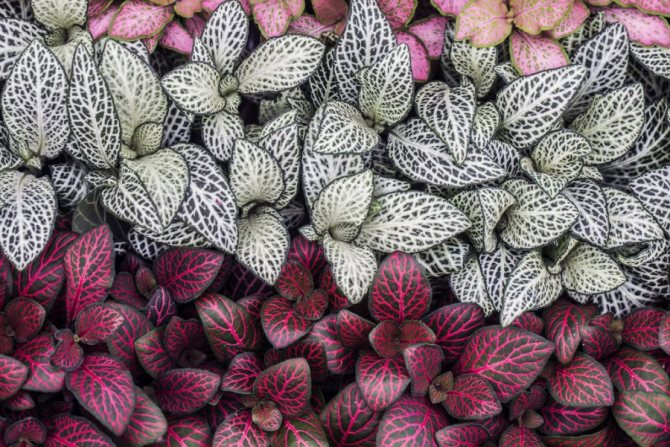

Hybrids resulting from breeding work.
- White Anna is distinguished by a white pattern and a dark border around the edge of the leaf blade.
- The skeleton is characterized by small velvety leaves that match the veining pattern. The combination of olive green and bright red pattern creates an amazing glowing sensation.
- Josan shows pink lace on the same shade of the leaf plate and an almost black edge.
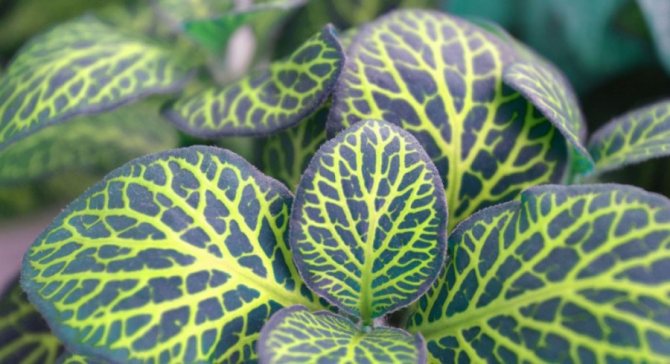

The mix is a mixture of colors. Foliage of different varieties is unusually spectacular if it is in the same container. This property is successfully used by florists for decoration.


On the video, you can clearly see the entire palette of several types of paints and appreciate their beauty.


The nuances of planting and transplanting
Fittonia must be replanted annually in early spring. A store-bought plant is left alone for a week. After this period, fittonia is transplanted. To ensure plant comfort, it is important to choose the right pot and prepare the soil.
Many gardeners recommend planting several bushes of colorful fittonia in one pot. This will help create a unique design composition.
Pot selection
Fittonia's roots are close to the surface, so a deep pot is not required for this plant. Moreover, it should be wide enough. The ideal option is a pot about 8 cm high and about 18 cm wide.
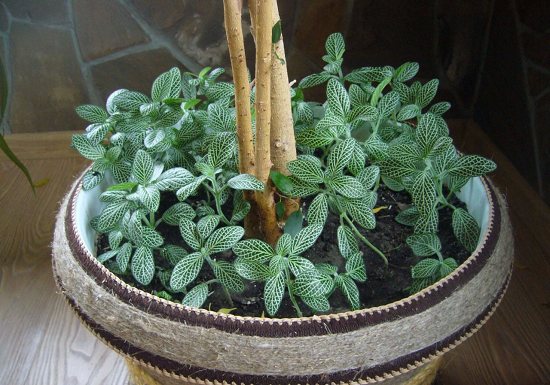

Wide and low pots are best for fittonia.
Important! The pot must have drainage holes through which excess moisture will be removed.
Soil preparation
Fittonia is suitable for light and rather loose soil. If you decide to buy it in a store, it is best to opt for soils intended for growing violets and geraniums. When self-preparing the soil, you should mix coniferous or turf soil with peat, as well as sand in proportions of 2: 1: 1.
Before planting fittonia, drainage should be laid at the bottom of the pot. For this purpose, you can use expanded clay, pebbles and chipped bricks.
Important! Drainage and soil mixture for Fittonia must be disinfected beforehand. To do this, they are spilled with boiling water or heated in the oven.
Transplant instructions
Before transplanting, it is necessary to shorten the long shoots of Fittonia. After that, the following sequence of actions is performed:
- The selected drainage is poured onto the bottom of the pot, and 1-2 cm of soil is covered on top.
- The plant is carefully removed from the old pot, being careful not to damage the roots.
- Excess soil is gently shaken off.
- The root system is inspected for rot. If they find it, the damaged roots are carefully cut off with a sharp knife. The cut points are sprinkled with crushed coal.
- Fittonia is installed in a new pot, fresh soil is poured on the sides and on top.
- The flower is watered abundantly, the excess water is poured from the pan.
Video: features of plant transplant
Difficulties encountered
Most often, the plant is affected by the scabbard, spider mite. You can get rid of the scale insect by washing the leaves with a sponge dipped in soapy water.
Then it is sprayed with actellik solution (at a concentration of 0.15%). Fitoverm and fufan will help against spider mites - they are sprayed with all the leaves and stems of fittonia.
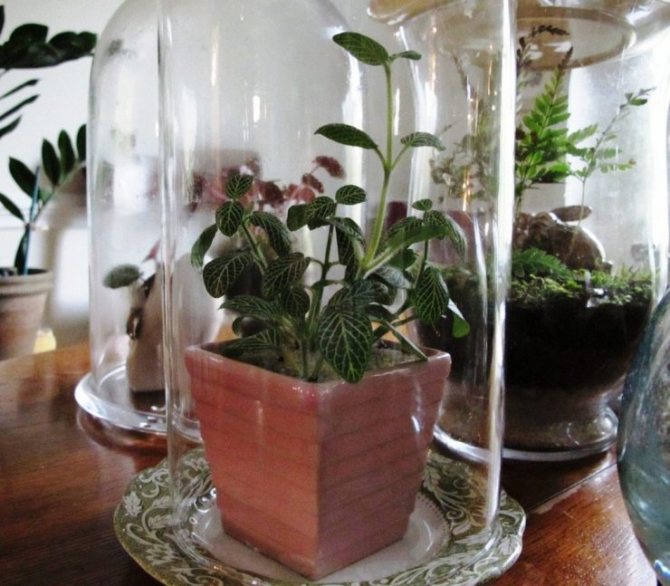

Due to improper care, such problems appear:
- the ends of the leaves dry - the air in the room is very dry;
- leaves turn yellow-brown - too much or not enough feeding;
- leaf spot, folded leaves - the soil is too dry;
- leaves lose color and dry out - too bright light, direct rays;
- leaves fall - low air humidity, excess watering.


Reproduction
Cutting - with three or five leaves, cut off the cutting with a sharp tool, leave the cuttings in a glass of water or aqua soil until roots are formed.Then plant in a mini-greenhouse, with a temperature of + 25 ... + 28 ° C, cover with transparent film, glass, do not forget to open it during the day, after rooting - transplant into a separate pot.
Thus, most indoor flowers are propagated - petunia, ficus, geranium, crossandra.
Division - divide the bush into parts, plant each in a separate pot, trying not to damage the fragile roots.
For reproduction by branching, after cutting off the leaves, sprinkle the long stems with moist soil. A few weeks later, when the roots appear, they should be separated and planted in prepared pots.
Seed propagation is not so popular; this can be done only if there is a very high quality seed. In spring, sow in pre-treated, damp soil, cover with foil and place in a lighted place with a temperature of +25 ° C. After the sprouts appear, remove the film, dive after the appearance of 3-5 leaves.


Leaf problems
- Turn yellow, darken, dry out: insufficient humidity - spray more often.
- They droop, curl, shoots wither: insufficient watering - normalize the frequency and abundance.
- The tips turn pale, dry out: an excess or lack of fertilizer, if you are not sure of the reason, transplant.
- They become small and rare, the shoots are stretched: lack of light - rearrange the flower or illuminate it with lamps.
- Light spots, the pattern fades: sunburn - move to a place with diffused light.
- Falling leaves: if the plant is older than 2 years and the lower leaves fall off - the process is natural, in other cases it is a lack of nutrients.
Useful properties of fittonia


A comfortable atmosphere is created in the room where Fittonia stands, because this plant perfectly cleans and disinfects the air. Often a pot with this motley beauty is placed in the bedroom, because it normalizes sleep. Esotericists are convinced that the flower has a beneficial effect on the energy in the house. Since its leaves are non-toxic, you don't have to worry if your pets want to eat them.
What kind of overseas fruit?
Fittonia flower is a small bush with brown stems. The plant has oval-shaped leaves with a bright green color and pink or white veins - they give the flower a general exotic look.
The flowers are small and yellow in color. Small flowers are collected in a spikelet-shaped inflorescence.
Depending on the variety, the plant reaches a height of 30-60 cm, it is accustomed to a humid climate and can grow only at high humidity, which is just the way for growing in certain regions of Russia.

